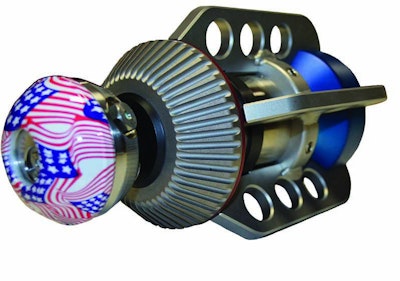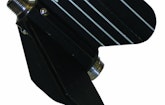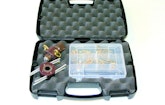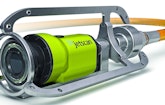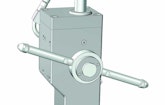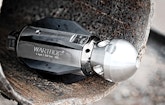
Interested in Waterblasting?
Get Waterblasting articles, news and videos right in your inbox! Sign up now.
Waterblasting + Get AlertsThe type of nozzle you choose is the most important factor when it comes to cleaning sewer lines efficiently, yet it is perhaps the most ignored piece of the system. Over the years, the number and types of sewer cleaning nozzles have expanded greatly with many specialty designs now on the market.
“Know your system.” That’s the first piece of advice from Scott Paquet, president and CEO of NozzTeq. The right nozzle means your truck won’t work as hard so you’ll save fuel, and the cleaning will be more efficient to save you time. Both save you money.
“It’s not the truck that cleans the pipe, it’s the system,” says Sales Manager Josh Ballum. “When you’re picking a nozzle, you need to know what your system is running, not the specs.” What your truck is putting out in flow and pressure is probably not what you think it is; that’s why NozzTeq tests customer equipment at the end of the hose.
Know the nozzle
Nozzles have come a long way in the last 10 to 15 years. “There’s different technology for every nozzle and every one does something different,” Paquet says.
The National Association of Sewer Service Companies lists three tiers of nozzles:
- Tier 1 — steel housing with orifices drilled in different locations, sizes, and angles.
- Tier 2 — replaceable inserts for longer life; some have flow straighteners for better performance.
- Tier 3 — higher capacity and more effective cleaning by directing flow more efficiently for less energy loss.
The more specialized the nozzle, the more you will pay; anywhere from around $100 to a few thousand dollars. Spending more to get the right one can result in significant improvement.
“I can get more power with a truck running just above idle with a tier 3 nozzle than with a tier 2 nozzle running the truck wide open,” Ballum says. Less resistance in the nozzle means less power needed from the truck.
He strongly suggests viewing an above-ground test. “With a tier 1 or 2 nozzle, the truck will be running wide open and the spray will be all mist. If I use a tier 3 nozzle, the truck will be running just above idle and you’ll see water streams shooting straight as an arrow for 30 feet. The straighter the stream, the more power you have.”
Know the job
What you do determines the nozzle package you need. “I’ll meet a contractor cleaning a large-diameter pipe and he’ll have a round nozzle with jets all the way around,” adds Ballum. “But all the debris is from 3 o’clock to 9 o’clock.” Instead of wasting water and pressure, the contractor would be much better off with a nozzle that has fewer jets aimed in the right direction.
He has also seen people cleaning small pipes without a penetrator spray. “They want to use the speed of the hose to break through the blockage when the right nozzle would break right through.”
Others may use their penetrator nozzle when there is no blockage, wasting water, pressure and fuel. Or they may use a workhorse nozzle, which is much more expensive, in place of a penetrator, which can result in it being damaged by getting stuck in the line.
It’s all about efficiency, the right tool for the right job, according to Paquet. “If the truck is meant to run at 2,000 rpm and you can put a nozzle on that allows you to run at 1,200 rpm and at lower pressure, what does that save in the long run? It means less fuel and less wear and tear on your truck, and you’re cleaning faster.”
From cutting to cleaning, here are the best nozzles the industry has to offer to help you tear through the toughest blockages:
- Manufactured from an aerospace elastomer, the flexible Cnt-r-Kut centering device from Arthur Products conforms to damaged or deformed lines, and can easily be trimmed in the field to fit virtually any line from 2 to 8 inches in diameter.
- Root Rat cutting nozzles from Chempure Products are used with jetters from 11 hp to large truck-mounted models.
- Deployed on any 3/4- or 1 1/2-inch jetter hose, the JetScan HD video nozzle from Envirosight allows cleaning crews to determine what tools and setup to use, identify blockages during emergency call-outs, and document the outcome of cleaning operations.
- The Golden Jet Bulldog rotating nozzle from Enz USA operates with both recycled and freshwater.
- The Warthog WGR Magnum high-performance rotary nozzle from StoneAge is designed to operate a long time between maintenance intervals.
- The EZ-8 automated rotary impingement tank cleaning machine from Gamajet eliminates time-intensive and hazardous manual cleaning.
- The Turbinator high-performance rotating nozzle with controlled rotation speed from USB – Sewer Equipment Corporation is operated with high-pressure water that drives the nozzle and creates vibrating cleaning jets.
- Multi-Global series sewer nozzles from NozzTeq have replaceable orifices similar to the company’s Ice Bear design.
- The 2.5D automatic tank cleaner from Hammelmann Corp. removes deposits including hardened materials from tank internal walls at pressures up to 23,150 psi and flows exceeding 200 gpm.
